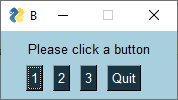Callback Function Simulation
The architecture of some programs works better with button callbacks instead of handling in-line. While button callbacks are part of the PySimpleGUI implementation, they are not directly exposed to the caller. The way to get the same result as callbacks is to simulate them with a recipe like this one.

import PySimpleGUI as sg
sg.theme('Light Blue 3')
# This design pattern simulates button callbacks
# This implementation uses a simple "Dispatch Dictionary" to store events and functions
# The callback functions
def button1():
print('Button 1 callback')
def button2():
print('Button 2 callback')
# Lookup dictionary that maps button to function to call
dispatch_dictionary = {'1':button1, '2':button2}
# Layout the design of the GUI
layout = [[sg.Text('Please click a button', auto_size_text=True)],
[sg.Button('1'), sg.Button('2'), sg.Button('3'), sg.Quit()]]
# Show the Window to the user
window = sg.Window('Button callback example', layout)
# Event loop. Read buttons, make callbacks
while True:
# Read the Window
event, value = window.read()
if event in ('Quit', sg.WIN_CLOSED):
break
# Lookup event in function dictionary
if event in dispatch_dictionary:
func_to_call = dispatch_dictionary[event] # get function from dispatch dictionary
func_to_call()
else:
print('Event {} not in dispatch dictionary'.format(event))
window.close()
# All done!
sg.popup_ok('Done')